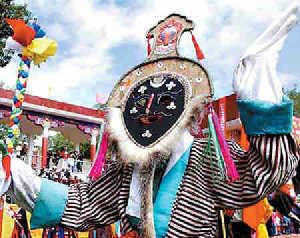 Four schools and eight great classical operas
Four schools and eight great classical operas
 Today, Tibetan Opera has four schools:
Today, Tibetan Opera has four schools:
1. The Goinba School
The Goinba School, originating in Ngamring and Lhaze counties of Southwest China's Tibet Autonomous Region, features high-pitched and sonorous singing, mixed with songs and dances from the Doi area, and traditionalacrobatics.
2. The Gyanggar School
The Gyanggar School is popular in Rinbung, Gyangze, and Xigaze, and is characterized by an ancient, rugged, and solemn style derived from Lamaism.
3. The Xangba School
The Xangba School from western Tibet combines the influence of local folklore and the Gyanggar School.
4. The Gyormolung School
The Gyormolung School from the Shannan and Lhasa areas is the most recently established school. Specializing in singing, choreography, stunts, and comic effects, it is the most developed among the four schools and has formed a jubilant style with rich and colorful songs and dances. Today, Gyormolung troupes are active in different parts of Tibet and are even known inSichuan Province's Garze region as well as the Southeast Asian countries of India and Bhutan.
Tibetan Opera reflects the Tibetan people's lives from various periods. The original scripts from which the opera was adapted have remained popular readings among Tibetans for centuries. Currently there are about 20 traditional repertoires (although some of the scripts have been lost and only the names and some of the plots remain).
The famous Eight Great Classical Tibetan Operas include Prince Nor-bzang, Maiden Vgro-ba-bzang-mo, Brothers Don-yod and Don-grub, Prince Dri-med-Kun-idan, Princess Wencheng, Gzugs-kyi-nyi-ma, Pad-ma-vod-vba, and Maiden Shang-sa -- most of which were derived from historic events, famous lives, folk tales, and stories from the sutras.
 Rebirth of the legendary opera
Rebirth of the legendary opera
Throughout the ages Tibetan Opera has played a central role in the life of the Tibetan people. It features prominently in a number of Tibetan festivals andtemplefairs, some of which are specifically designed for it, such as the Shoton Festival (also known as Yoghurt Festival). By the 19th century most districts in Tibet had their own opera troupes.
The opera spread from Shannan, Xigaze, and Lhasa to other parts of Tibet, and further into Southwest China's Sichuan andYunnan provinces, Northwest China's Qinghai andGansu provinces, and the neighboring countries of India, Bhutan, and Nepal.
